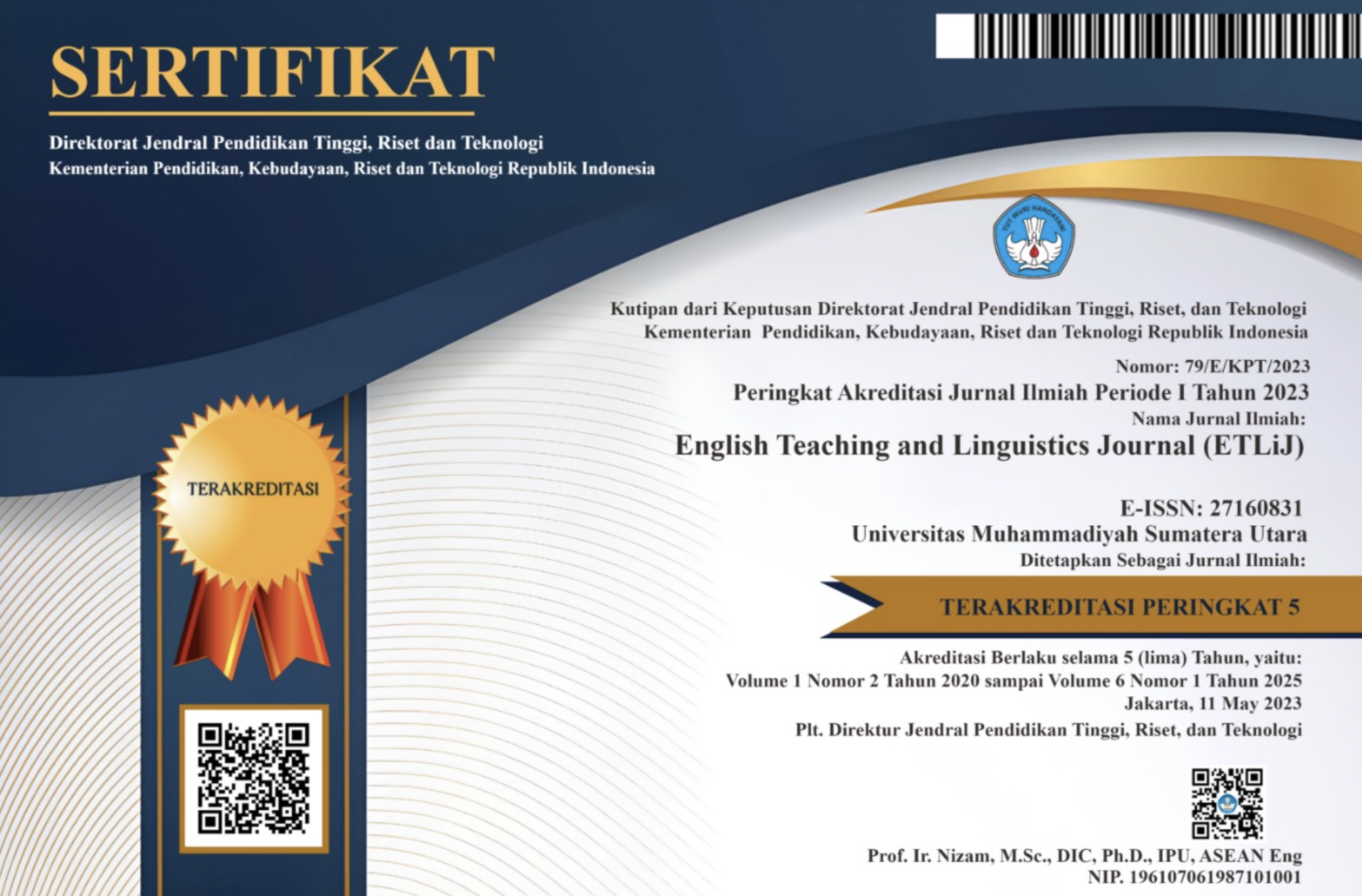English Teachers Classroom Management : Cultivating Students Creativity in Indonesian Junior High School
Abstract
This study aims to find out how the creativity of a teacher in managing the class to foster student creativity at SMP Negeri 12 Tebo Regency. The object of this research is an English subject teacher at SMP Negeri 12 Tebo Regency. The method used is descriptive qualitative method in the form of survey research. Data was taken by direct communication techniques, namely in the form of interviews. While the data processing technique is using deduction reasoning, which means drawing conclusions from the general to the specific. Deductive reasoning is drawing conclusions from a general premise or assumption to make a special logical conclusion. The results showed that the English teacher at SMP N 12 Tebo Regency already had criteria for a creative teacher in the teaching and learning process, such as the teacher already had a great curiosity when teaching, the teacher already had a flexible nature, the teacher already had a sense of humor, the teacher already have an inspiring nature, the teacher already has a positive and empathetic attitude, the teacher has dared to take risks, such as instructing students to make media that will be used for learning and the teacher has also used existing facilities or media.
Keywords
Full Text:
PDFReferences
Akyildiz, S.T, & Celik, V. (2020). Thinking Outside the Box : Turkish EFL Teachers Perceptions of Creativity. Elsevier. https : doi. Org / 10.1016 / j.tsc. 2020. 100649.
Alicia, V. (2008). Presented In Partial Fullfillment Of The Requirement For The Degree Master Program Of English Education Faculty Of Educational Sciences. Syarif Hidayatullah State Islamic University Jakarta.
Daher, W. (2022). students creativity Teachers classroom management for motivating students creativity. Middle School Journal, 53(4), 2839. https://doi.org/10.1080/00940771.2022.2096818.
de Souza Fleith, D. (2000). Teacher and student perceptions of creativity in the classroom environment. Roeper Review, 22(3), 148-153.
Dunbar, C. (2004). Best Practices in Classroom Management.
Fossey, E., Harvey, C., Mcdermott, F., & Davidson, L. (2002). research *.
Hang, L. T., & Van, V. H. (2020). Building strong teaching and learning strategies through teaching innovations and learners creativity: A study of vietnam universities. International Journal of Education and Practice, 8(3), 498510. https://doi.org/10.18488/journal.61.2020.83.498.510
Henriksen, D., Henderson, M., Creely, E., Carvalho, A. A., Cernochova, M., Dash, D., Davis, T., & Mishra, P. (2021). Creativity and risk-taking in teaching and learning settings: Insights from six international narratives. International Journal of Educational Research Open, 2, 100024. https://doi.org/10.1016/j.ijedro.2020.100024
Hosseini, A. S. (2014). The Effect of Creativity Model for Creativity Development in Teachers. International Journal of Information and Education Technology, 4(2), 138142. https://doi.org/10.7763/ijiet.2014.v4.385
Irianto, N. andesta, Imranuddin, & Syafrizal. (2019). Journal of English Education and Teaching (JEET) e-ISSN: 2622-5867. Journal of English Education and Teaching )JEET), 3(4), 522532.
Jonibek, H. (2022). Future Technology Creativity of Teachers Some Aspects of Development. 4, 5558.
Kettler, T., Lamb, K. N., Willerson, A., & Mullet, D. R. (2018). Teachers perceptions of creativity in the classroom. Creativity Research Journal, 30(2), 164-171.
Khodabakhshzadeh, H., Hosseinnia, M., Moghadam, H. A., & Ahmadi, F. (2018). EFL teachers creativity and their teachings effectiveness: A structural equation modelling approach. International Journal of Instruction, 11(1), 227238. https://doi.org/10.12973/iji.2018.11116a
Ming-tak, H., & Shing, L.W. (2008). Classroom Management :Creating A Positive Learning Environment. Hongkong University Press.
Mirzaee, A., & Rahimi, M. (2017). An investigation on relationship between Iranian EFL teachers creativity and classroom management strategies and learners improvement. in English Language Teaching, 5(4), 3145. http://european-science.com/jaelt/article/view/5254.
Newbill, P., & Baum, L. (2012). Design Creativity. ISTE (International Society for Technology in Education.
Pentury, H. J., Studi, P., & Bahasa, P. (2017). PENGEMBANGAN KREATIVITAS GURU. 4(3), 265272.
Rais, S., Rubini, B., & Herfina. (2022). Increasing Teacher Creativity through Strengthening Transformational Leadership, Teamwork, and Work Engagement. Pegem Egitim ve Ogretim Dergisi, 12(1), 232241. https://doi.org/10.47750/pegegog.12.01.24
Rotherham, A. J., & Willingham, D. (2009). to work, the 21st Century Skills Movement Will Require Keep Attention To Curriculum, Teacher Quality, And Assessment.
Saleh, S., Emiliani, R., Nasrullah, M., & Arhas, S. H. (2021).Creativity In Teaching Teachers In The Department Of Office Administration Automation Or (OTKP) at SMK Nurul Qalam Makassar. Jurnal Office : Jurnal Pemikiran Ilmiah Dan Pendidikan Administrasi Perkantoran. 7(2). 225-233.
Sari, S.M. (2017). Pengaruh Kreativitas Guru Dalam Pembelajaran Terhadap Hasil Belajar Mata Pelajaran Pendidikan Agama Islam Peserta Didik Kelas VIII SMPN 3 Batanghari. Institut Agama Islam Negeri (IAIN) Metro.
Sukardi, R. R., Sopandi, W., & Riandi. (2021). How do teachers develop secondary school students creativity in the classroom? AIP Conference Proceedings, 2331(April). https://doi.org/10.1063/5.0042030.
Suwartono. (2016). Teacher's Creativity In ELT. International Seminar On English Language Teaching (ISELT).
Tamsah, H., Ilyas, J. B., & Yusriadi, Y. (2021). Create teaching creativity through training management, effectiveness training, and teacher quality in the covid-19 pandemic. Journal of Ethnic and Cultural Studies, 8(4), 1835. https://doi.org/10.29333/ejecs/800
Triana, Y., Weran, I., & Kuswandono, P. (2021). Generating Creativity in Elementary School Teaching : A Case Study of Teacher Professional Development in Indonesia. 10(1), 1730. https://doi.org/10.21580/vjv10i17454
Untari, S. K. (2020). Kreatifitas Guru Dalam Menyongsong Pembelajaran Masa Pandemi Covid- 19. Buana Pendidikan: Jurnal Fakultas Keguruan Dan Ilmu Pendidikan, 16(30s), 4953. https://doi.org/10.36456/bp.vol16.no30s.a2757
Wang, L., & Kokotsaki, D. (2018). Primary school teachers conceptions of creativity in teaching English as a foreign language (EFL) in China. Thinking Skills and Creativity. https://doi.org/10.1016/j.tsc.2018.06.002
Wayan Widana, I. (2020). The Effect of Digital Literacy on the Ability of Teachers to Develop HOTS-based Assessment. Journal of Physics: Conference Series, 1503(1). https://doi.org/10.1088/1742-6596/1503/1/012045
DOI: https://doi.org/10.30596/etlij.v4i1.12981
Refbacks
- There are currently no refbacks.

This work is licensed under a Creative Commons Attribution 3.0 License
ISSN: 2716-0831





